MC6001: Media's Role in Addressing Childhood Obesity - Analysis
VerifiedAdded on 2023/06/09
|19
|4465
|322
Report
AI Summary
This report conducts a content analysis to evaluate how childhood obesity is represented and addressed in the media, focusing on the implications of media messages aimed at young people in the United Kingdom. It identifies the implications of media messages on young people's understanding of obesity causes, assesses effective ways media addresses childhood obesity, and evaluates expected outcomes of media expressing the causes of obesity and ways of dealing with the health issue. The research employs a descriptive research design, positivism research philosophy, and deductive research approach, utilizing mixed methods for data collection and analysis. The report also formulates recommendations for promoting public service announcements and media messages to enhance children's understanding of healthy food consumption.
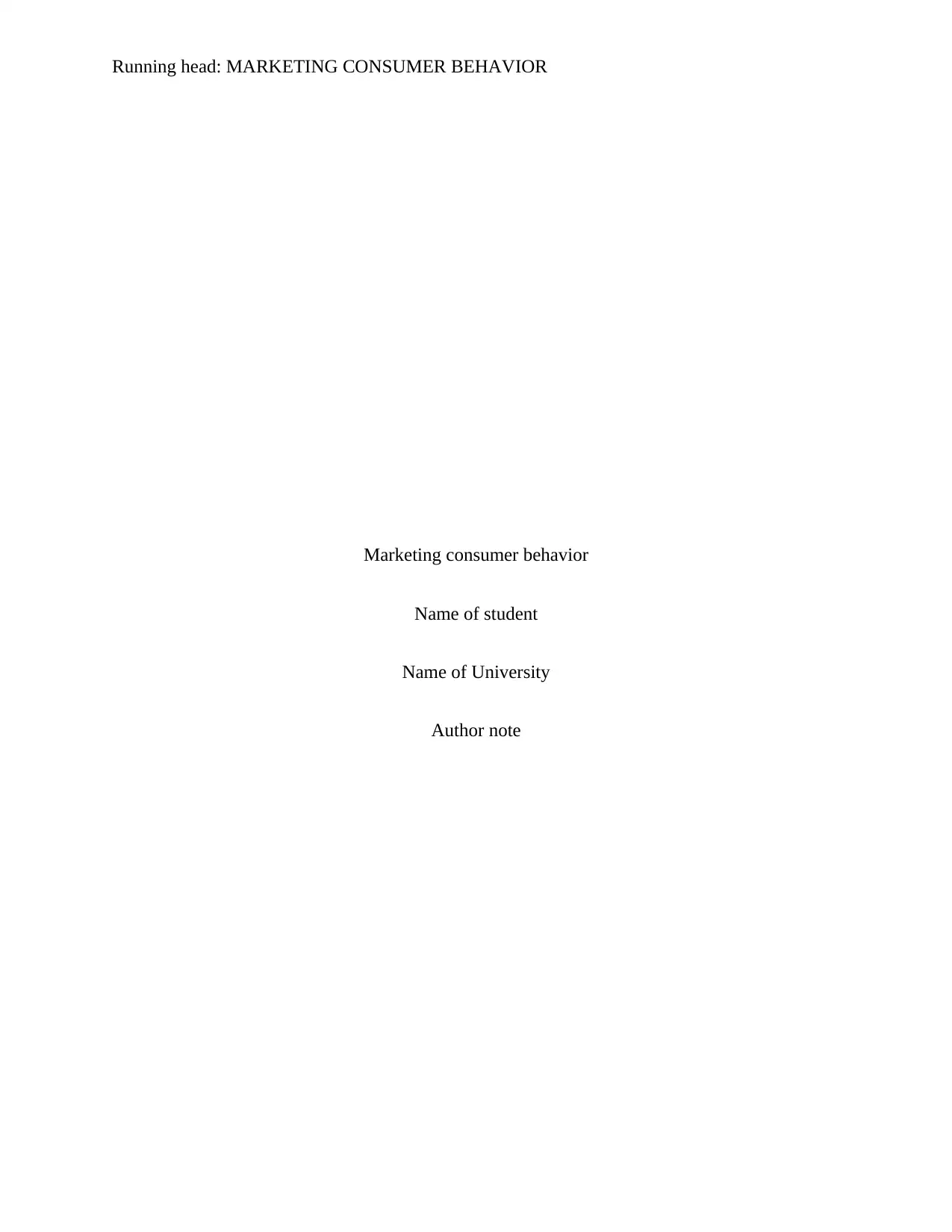
Running head: MARKETING CONSUMER BEHAVIOR
Marketing consumer behavior
Name of student
Name of University
Author note
Marketing consumer behavior
Name of student
Name of University
Author note
Paraphrase This Document
Need a fresh take? Get an instant paraphrase of this document with our AI Paraphraser
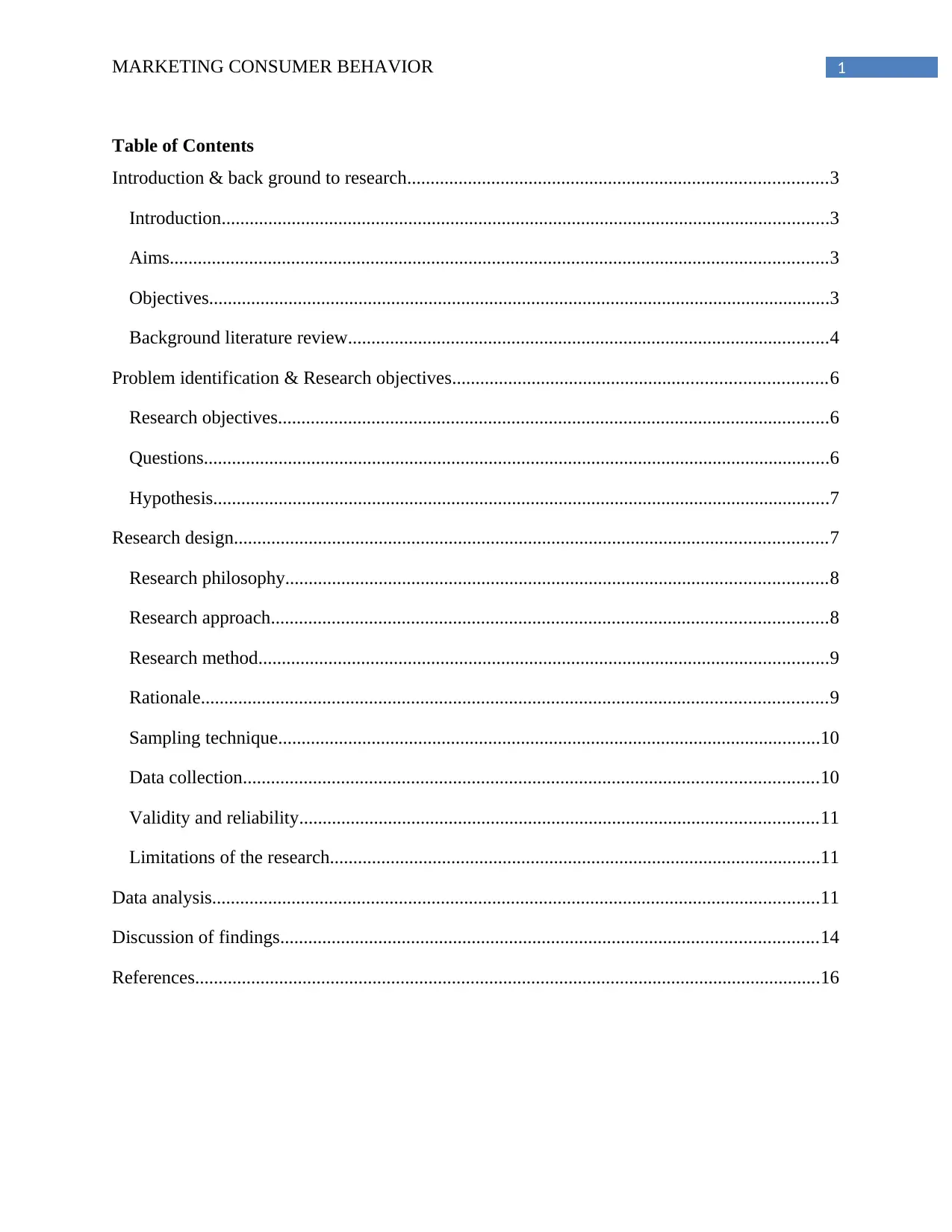
1MARKETING CONSUMER BEHAVIOR
Table of Contents
Introduction & back ground to research..........................................................................................3
Introduction..................................................................................................................................3
Aims.............................................................................................................................................3
Objectives.....................................................................................................................................3
Background literature review.......................................................................................................4
Problem identification & Research objectives................................................................................6
Research objectives......................................................................................................................6
Questions......................................................................................................................................6
Hypothesis....................................................................................................................................7
Research design...............................................................................................................................7
Research philosophy....................................................................................................................8
Research approach.......................................................................................................................8
Research method..........................................................................................................................9
Rationale......................................................................................................................................9
Sampling technique....................................................................................................................10
Data collection...........................................................................................................................10
Validity and reliability...............................................................................................................11
Limitations of the research.........................................................................................................11
Data analysis..................................................................................................................................11
Discussion of findings...................................................................................................................14
References......................................................................................................................................16
Table of Contents
Introduction & back ground to research..........................................................................................3
Introduction..................................................................................................................................3
Aims.............................................................................................................................................3
Objectives.....................................................................................................................................3
Background literature review.......................................................................................................4
Problem identification & Research objectives................................................................................6
Research objectives......................................................................................................................6
Questions......................................................................................................................................6
Hypothesis....................................................................................................................................7
Research design...............................................................................................................................7
Research philosophy....................................................................................................................8
Research approach.......................................................................................................................8
Research method..........................................................................................................................9
Rationale......................................................................................................................................9
Sampling technique....................................................................................................................10
Data collection...........................................................................................................................10
Validity and reliability...............................................................................................................11
Limitations of the research.........................................................................................................11
Data analysis..................................................................................................................................11
Discussion of findings...................................................................................................................14
References......................................................................................................................................16
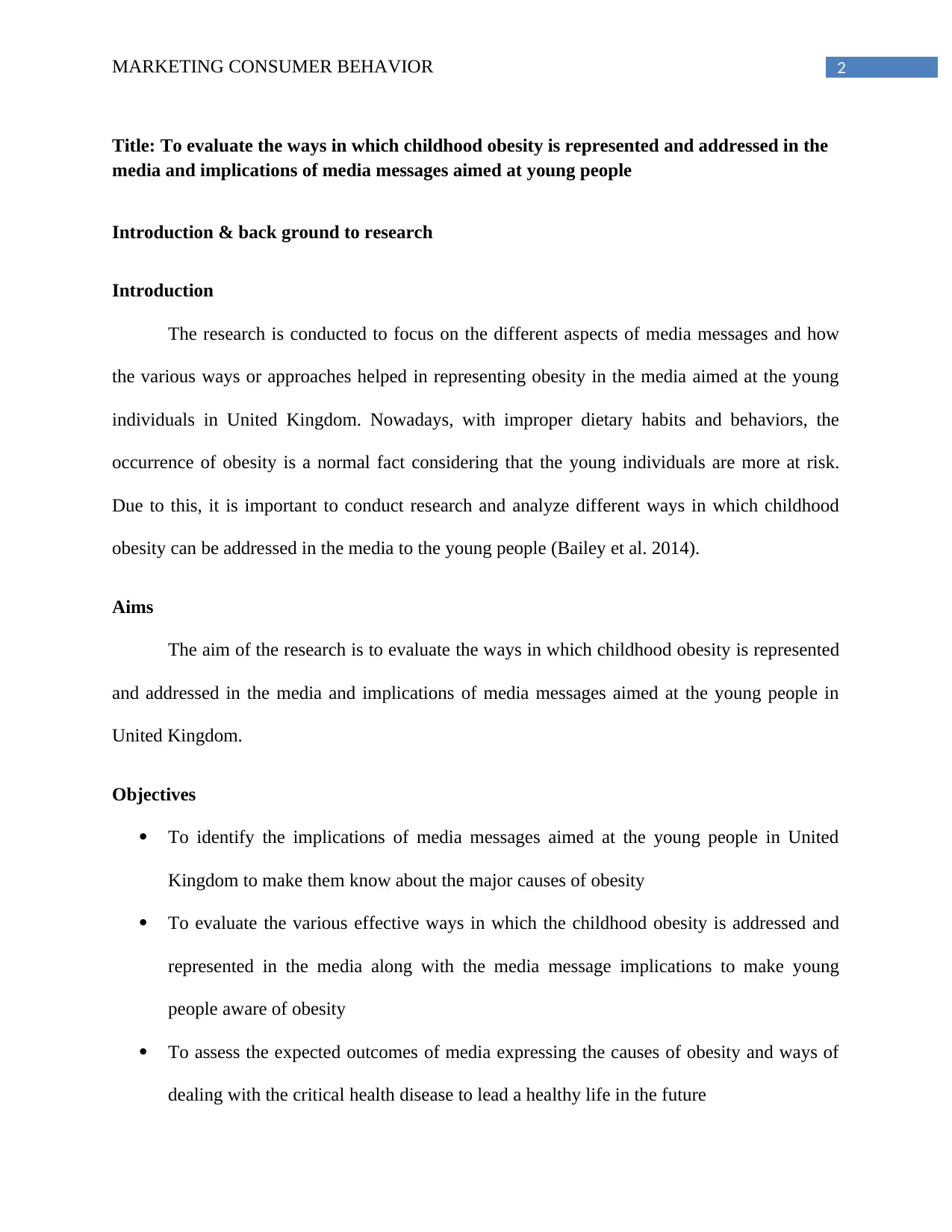
2MARKETING CONSUMER BEHAVIOR
Title: To evaluate the ways in which childhood obesity is represented and addressed in the
media and implications of media messages aimed at young people
Introduction & back ground to research
Introduction
The research is conducted to focus on the different aspects of media messages and how
the various ways or approaches helped in representing obesity in the media aimed at the young
individuals in United Kingdom. Nowadays, with improper dietary habits and behaviors, the
occurrence of obesity is a normal fact considering that the young individuals are more at risk.
Due to this, it is important to conduct research and analyze different ways in which childhood
obesity can be addressed in the media to the young people (Bailey et al. 2014).
Aims
The aim of the research is to evaluate the ways in which childhood obesity is represented
and addressed in the media and implications of media messages aimed at the young people in
United Kingdom.
Objectives
To identify the implications of media messages aimed at the young people in United
Kingdom to make them know about the major causes of obesity
To evaluate the various effective ways in which the childhood obesity is addressed and
represented in the media along with the media message implications to make young
people aware of obesity
To assess the expected outcomes of media expressing the causes of obesity and ways of
dealing with the critical health disease to lead a healthy life in the future
Title: To evaluate the ways in which childhood obesity is represented and addressed in the
media and implications of media messages aimed at young people
Introduction & back ground to research
Introduction
The research is conducted to focus on the different aspects of media messages and how
the various ways or approaches helped in representing obesity in the media aimed at the young
individuals in United Kingdom. Nowadays, with improper dietary habits and behaviors, the
occurrence of obesity is a normal fact considering that the young individuals are more at risk.
Due to this, it is important to conduct research and analyze different ways in which childhood
obesity can be addressed in the media to the young people (Bailey et al. 2014).
Aims
The aim of the research is to evaluate the ways in which childhood obesity is represented
and addressed in the media and implications of media messages aimed at the young people in
United Kingdom.
Objectives
To identify the implications of media messages aimed at the young people in United
Kingdom to make them know about the major causes of obesity
To evaluate the various effective ways in which the childhood obesity is addressed and
represented in the media along with the media message implications to make young
people aware of obesity
To assess the expected outcomes of media expressing the causes of obesity and ways of
dealing with the critical health disease to lead a healthy life in the future
⊘ This is a preview!⊘
Do you want full access?
Subscribe today to unlock all pages.

Trusted by 1+ million students worldwide
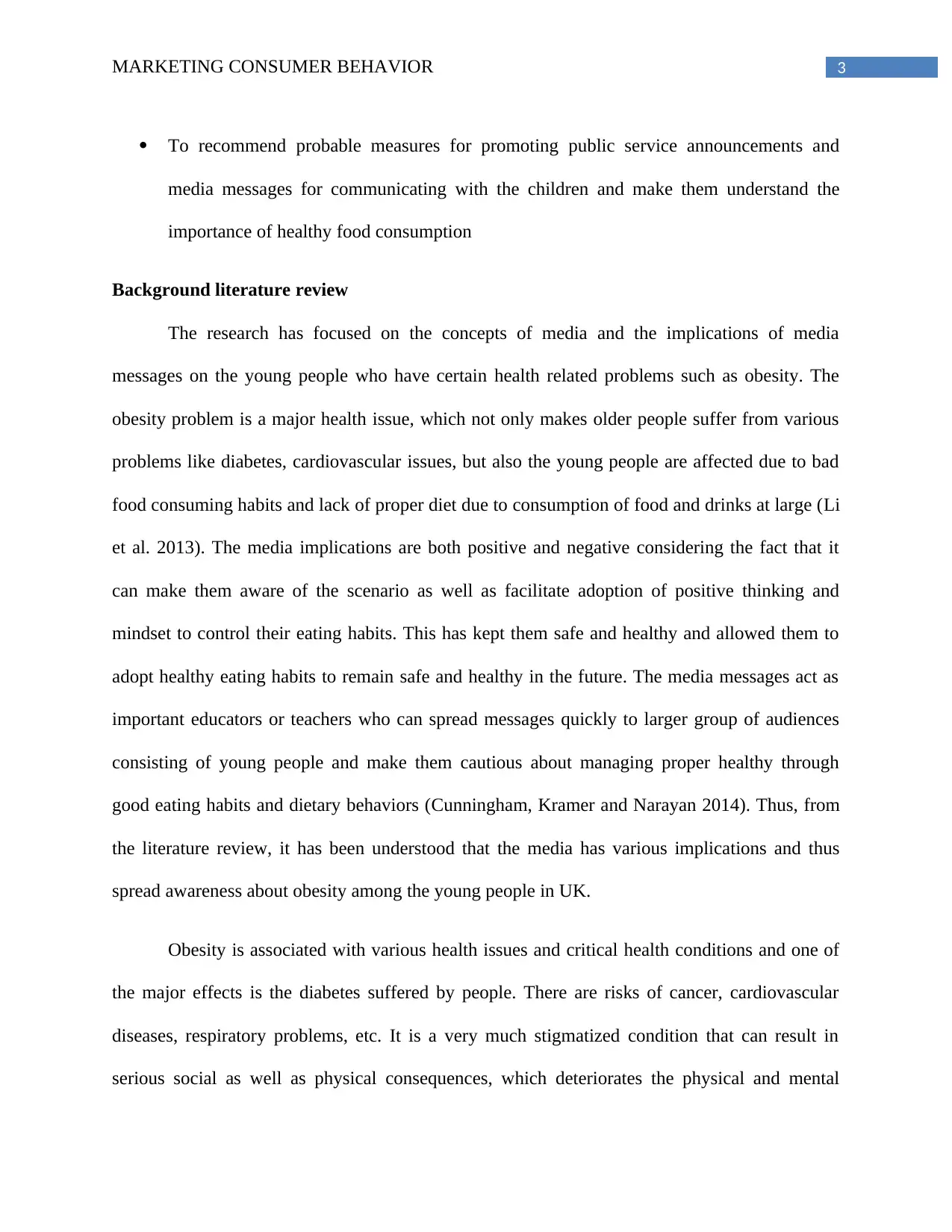
3MARKETING CONSUMER BEHAVIOR
To recommend probable measures for promoting public service announcements and
media messages for communicating with the children and make them understand the
importance of healthy food consumption
Background literature review
The research has focused on the concepts of media and the implications of media
messages on the young people who have certain health related problems such as obesity. The
obesity problem is a major health issue, which not only makes older people suffer from various
problems like diabetes, cardiovascular issues, but also the young people are affected due to bad
food consuming habits and lack of proper diet due to consumption of food and drinks at large (Li
et al. 2013). The media implications are both positive and negative considering the fact that it
can make them aware of the scenario as well as facilitate adoption of positive thinking and
mindset to control their eating habits. This has kept them safe and healthy and allowed them to
adopt healthy eating habits to remain safe and healthy in the future. The media messages act as
important educators or teachers who can spread messages quickly to larger group of audiences
consisting of young people and make them cautious about managing proper healthy through
good eating habits and dietary behaviors (Cunningham, Kramer and Narayan 2014). Thus, from
the literature review, it has been understood that the media has various implications and thus
spread awareness about obesity among the young people in UK.
Obesity is associated with various health issues and critical health conditions and one of
the major effects is the diabetes suffered by people. There are risks of cancer, cardiovascular
diseases, respiratory problems, etc. It is a very much stigmatized condition that can result in
serious social as well as physical consequences, which deteriorates the physical and mental
To recommend probable measures for promoting public service announcements and
media messages for communicating with the children and make them understand the
importance of healthy food consumption
Background literature review
The research has focused on the concepts of media and the implications of media
messages on the young people who have certain health related problems such as obesity. The
obesity problem is a major health issue, which not only makes older people suffer from various
problems like diabetes, cardiovascular issues, but also the young people are affected due to bad
food consuming habits and lack of proper diet due to consumption of food and drinks at large (Li
et al. 2013). The media implications are both positive and negative considering the fact that it
can make them aware of the scenario as well as facilitate adoption of positive thinking and
mindset to control their eating habits. This has kept them safe and healthy and allowed them to
adopt healthy eating habits to remain safe and healthy in the future. The media messages act as
important educators or teachers who can spread messages quickly to larger group of audiences
consisting of young people and make them cautious about managing proper healthy through
good eating habits and dietary behaviors (Cunningham, Kramer and Narayan 2014). Thus, from
the literature review, it has been understood that the media has various implications and thus
spread awareness about obesity among the young people in UK.
Obesity is associated with various health issues and critical health conditions and one of
the major effects is the diabetes suffered by people. There are risks of cancer, cardiovascular
diseases, respiratory problems, etc. It is a very much stigmatized condition that can result in
serious social as well as physical consequences, which deteriorates the physical and mental
Paraphrase This Document
Need a fresh take? Get an instant paraphrase of this document with our AI Paraphraser
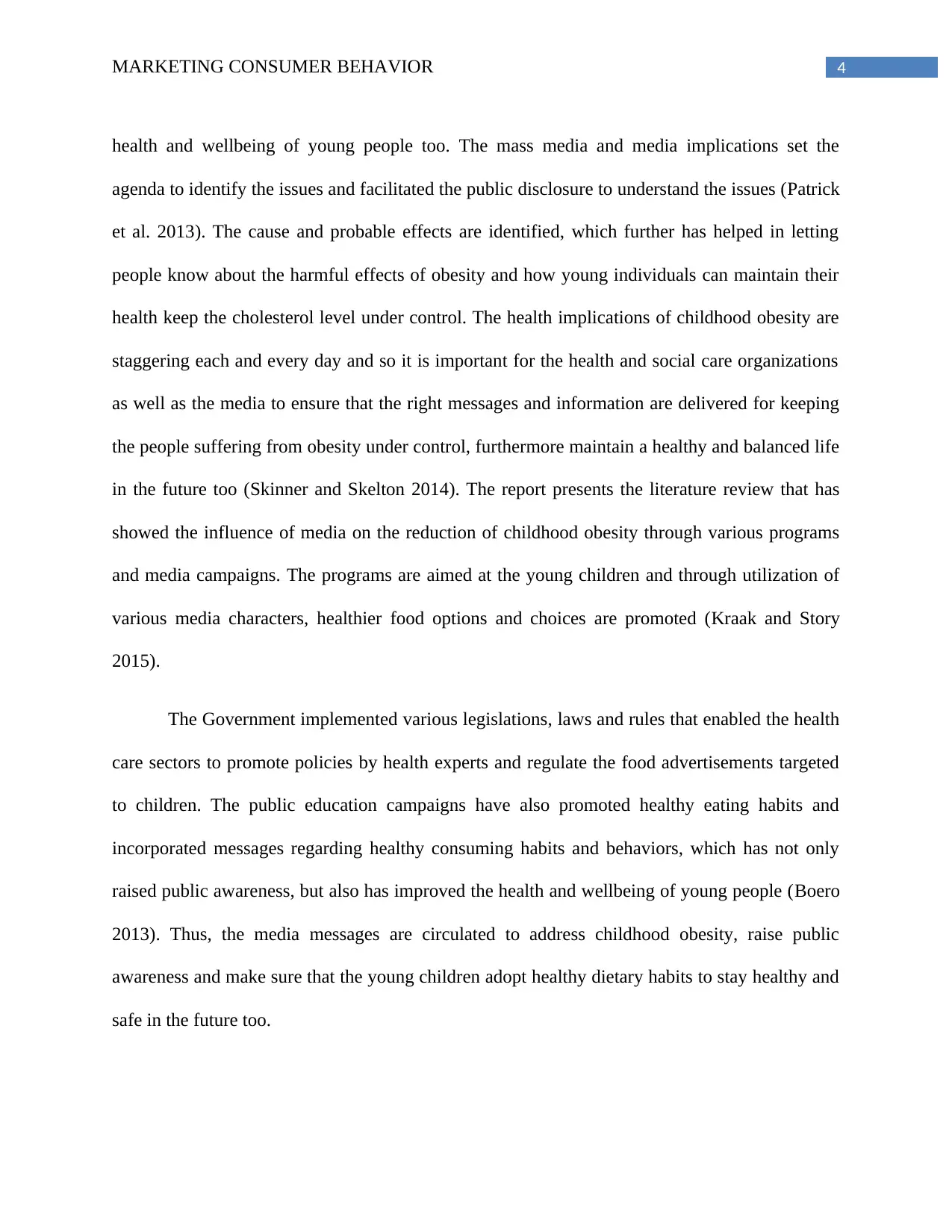
4MARKETING CONSUMER BEHAVIOR
health and wellbeing of young people too. The mass media and media implications set the
agenda to identify the issues and facilitated the public disclosure to understand the issues (Patrick
et al. 2013). The cause and probable effects are identified, which further has helped in letting
people know about the harmful effects of obesity and how young individuals can maintain their
health keep the cholesterol level under control. The health implications of childhood obesity are
staggering each and every day and so it is important for the health and social care organizations
as well as the media to ensure that the right messages and information are delivered for keeping
the people suffering from obesity under control, furthermore maintain a healthy and balanced life
in the future too (Skinner and Skelton 2014). The report presents the literature review that has
showed the influence of media on the reduction of childhood obesity through various programs
and media campaigns. The programs are aimed at the young children and through utilization of
various media characters, healthier food options and choices are promoted (Kraak and Story
2015).
The Government implemented various legislations, laws and rules that enabled the health
care sectors to promote policies by health experts and regulate the food advertisements targeted
to children. The public education campaigns have also promoted healthy eating habits and
incorporated messages regarding healthy consuming habits and behaviors, which has not only
raised public awareness, but also has improved the health and wellbeing of young people (Boero
2013). Thus, the media messages are circulated to address childhood obesity, raise public
awareness and make sure that the young children adopt healthy dietary habits to stay healthy and
safe in the future too.
health and wellbeing of young people too. The mass media and media implications set the
agenda to identify the issues and facilitated the public disclosure to understand the issues (Patrick
et al. 2013). The cause and probable effects are identified, which further has helped in letting
people know about the harmful effects of obesity and how young individuals can maintain their
health keep the cholesterol level under control. The health implications of childhood obesity are
staggering each and every day and so it is important for the health and social care organizations
as well as the media to ensure that the right messages and information are delivered for keeping
the people suffering from obesity under control, furthermore maintain a healthy and balanced life
in the future too (Skinner and Skelton 2014). The report presents the literature review that has
showed the influence of media on the reduction of childhood obesity through various programs
and media campaigns. The programs are aimed at the young children and through utilization of
various media characters, healthier food options and choices are promoted (Kraak and Story
2015).
The Government implemented various legislations, laws and rules that enabled the health
care sectors to promote policies by health experts and regulate the food advertisements targeted
to children. The public education campaigns have also promoted healthy eating habits and
incorporated messages regarding healthy consuming habits and behaviors, which has not only
raised public awareness, but also has improved the health and wellbeing of young people (Boero
2013). Thus, the media messages are circulated to address childhood obesity, raise public
awareness and make sure that the young children adopt healthy dietary habits to stay healthy and
safe in the future too.
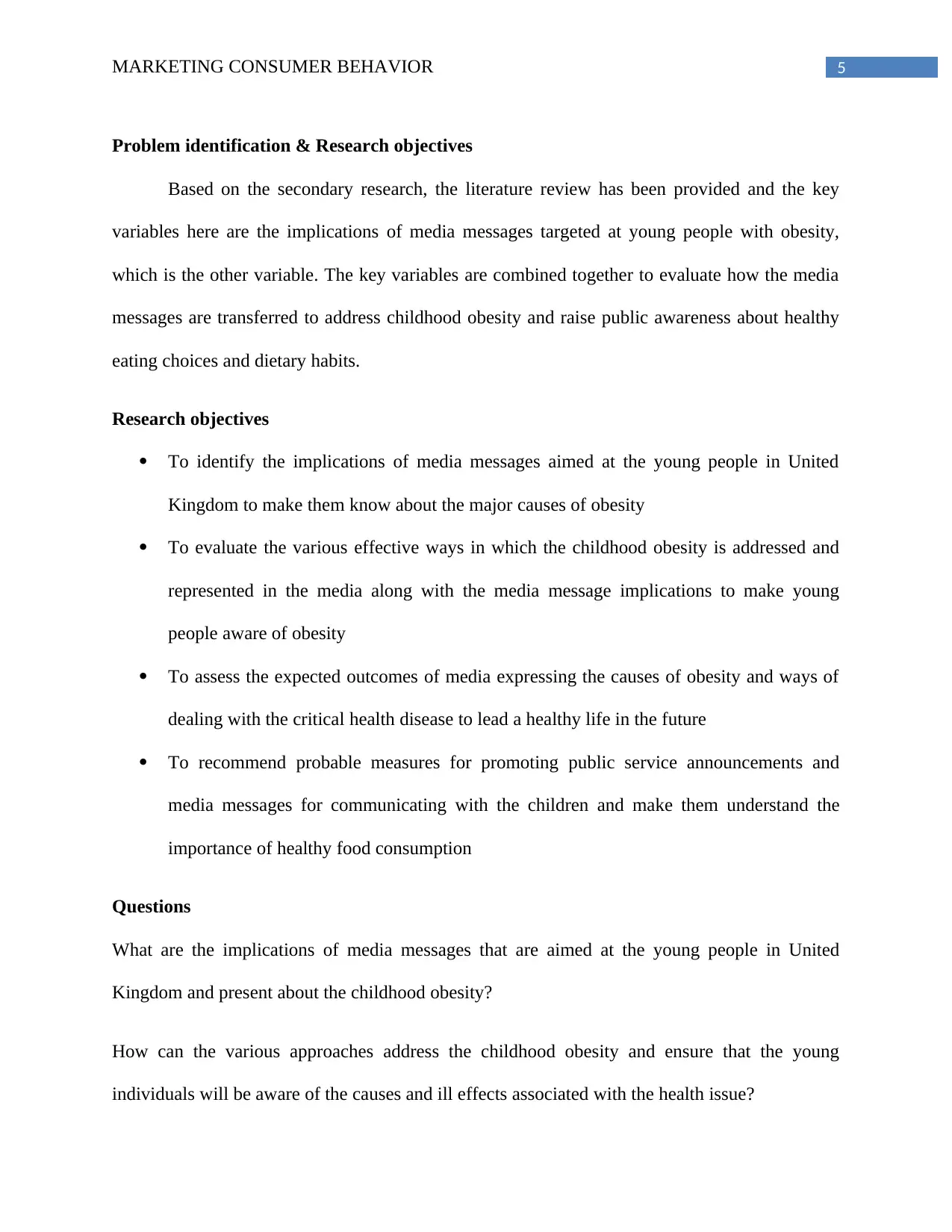
5MARKETING CONSUMER BEHAVIOR
Problem identification & Research objectives
Based on the secondary research, the literature review has been provided and the key
variables here are the implications of media messages targeted at young people with obesity,
which is the other variable. The key variables are combined together to evaluate how the media
messages are transferred to address childhood obesity and raise public awareness about healthy
eating choices and dietary habits.
Research objectives
To identify the implications of media messages aimed at the young people in United
Kingdom to make them know about the major causes of obesity
To evaluate the various effective ways in which the childhood obesity is addressed and
represented in the media along with the media message implications to make young
people aware of obesity
To assess the expected outcomes of media expressing the causes of obesity and ways of
dealing with the critical health disease to lead a healthy life in the future
To recommend probable measures for promoting public service announcements and
media messages for communicating with the children and make them understand the
importance of healthy food consumption
Questions
What are the implications of media messages that are aimed at the young people in United
Kingdom and present about the childhood obesity?
How can the various approaches address the childhood obesity and ensure that the young
individuals will be aware of the causes and ill effects associated with the health issue?
Problem identification & Research objectives
Based on the secondary research, the literature review has been provided and the key
variables here are the implications of media messages targeted at young people with obesity,
which is the other variable. The key variables are combined together to evaluate how the media
messages are transferred to address childhood obesity and raise public awareness about healthy
eating choices and dietary habits.
Research objectives
To identify the implications of media messages aimed at the young people in United
Kingdom to make them know about the major causes of obesity
To evaluate the various effective ways in which the childhood obesity is addressed and
represented in the media along with the media message implications to make young
people aware of obesity
To assess the expected outcomes of media expressing the causes of obesity and ways of
dealing with the critical health disease to lead a healthy life in the future
To recommend probable measures for promoting public service announcements and
media messages for communicating with the children and make them understand the
importance of healthy food consumption
Questions
What are the implications of media messages that are aimed at the young people in United
Kingdom and present about the childhood obesity?
How can the various approaches address the childhood obesity and ensure that the young
individuals will be aware of the causes and ill effects associated with the health issue?
⊘ This is a preview!⊘
Do you want full access?
Subscribe today to unlock all pages.

Trusted by 1+ million students worldwide
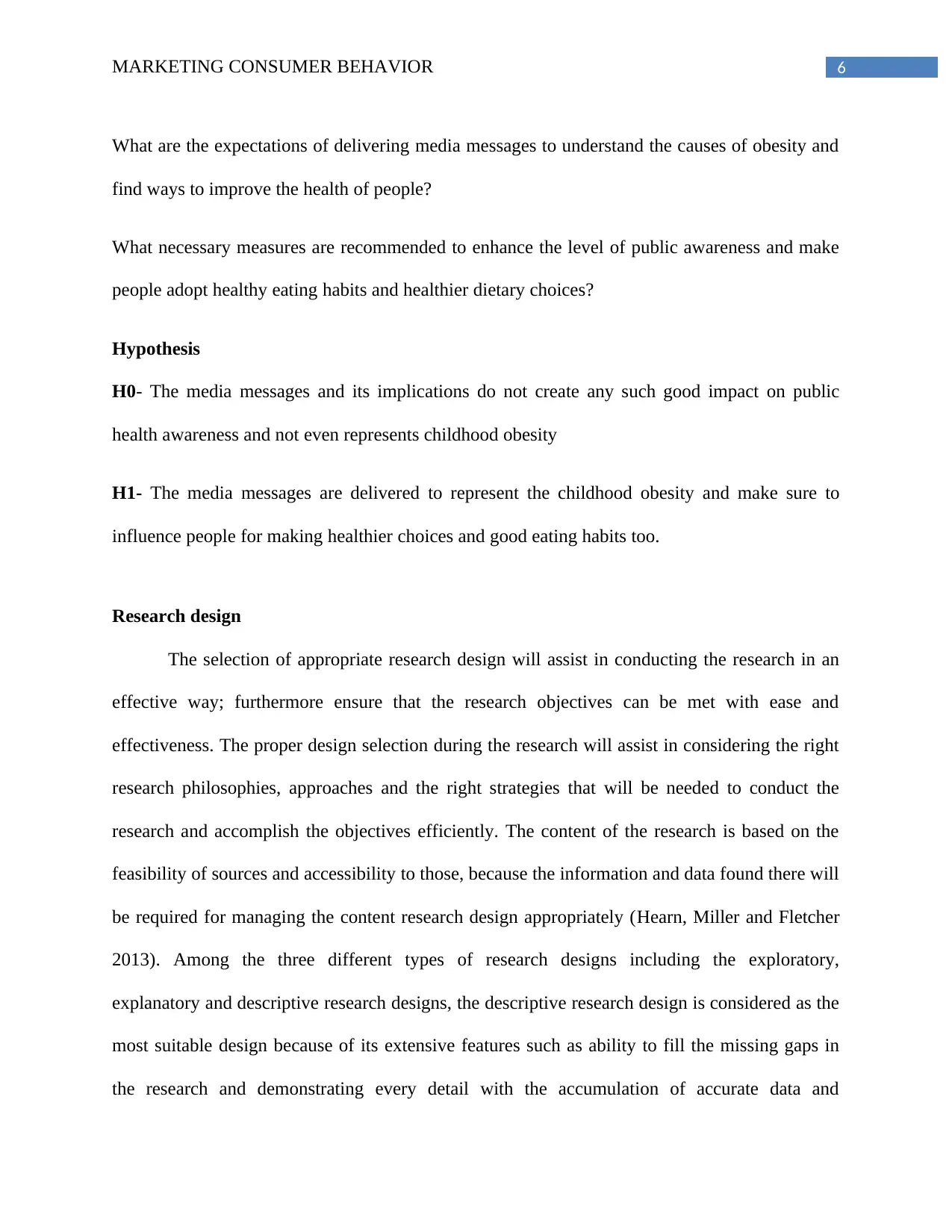
6MARKETING CONSUMER BEHAVIOR
What are the expectations of delivering media messages to understand the causes of obesity and
find ways to improve the health of people?
What necessary measures are recommended to enhance the level of public awareness and make
people adopt healthy eating habits and healthier dietary choices?
Hypothesis
H0- The media messages and its implications do not create any such good impact on public
health awareness and not even represents childhood obesity
H1- The media messages are delivered to represent the childhood obesity and make sure to
influence people for making healthier choices and good eating habits too.
Research design
The selection of appropriate research design will assist in conducting the research in an
effective way; furthermore ensure that the research objectives can be met with ease and
effectiveness. The proper design selection during the research will assist in considering the right
research philosophies, approaches and the right strategies that will be needed to conduct the
research and accomplish the objectives efficiently. The content of the research is based on the
feasibility of sources and accessibility to those, because the information and data found there will
be required for managing the content research design appropriately (Hearn, Miller and Fletcher
2013). Among the three different types of research designs including the exploratory,
explanatory and descriptive research designs, the descriptive research design is considered as the
most suitable design because of its extensive features such as ability to fill the missing gaps in
the research and demonstrating every detail with the accumulation of accurate data and
What are the expectations of delivering media messages to understand the causes of obesity and
find ways to improve the health of people?
What necessary measures are recommended to enhance the level of public awareness and make
people adopt healthy eating habits and healthier dietary choices?
Hypothesis
H0- The media messages and its implications do not create any such good impact on public
health awareness and not even represents childhood obesity
H1- The media messages are delivered to represent the childhood obesity and make sure to
influence people for making healthier choices and good eating habits too.
Research design
The selection of appropriate research design will assist in conducting the research in an
effective way; furthermore ensure that the research objectives can be met with ease and
effectiveness. The proper design selection during the research will assist in considering the right
research philosophies, approaches and the right strategies that will be needed to conduct the
research and accomplish the objectives efficiently. The content of the research is based on the
feasibility of sources and accessibility to those, because the information and data found there will
be required for managing the content research design appropriately (Hearn, Miller and Fletcher
2013). Among the three different types of research designs including the exploratory,
explanatory and descriptive research designs, the descriptive research design is considered as the
most suitable design because of its extensive features such as ability to fill the missing gaps in
the research and demonstrating every detail with the accumulation of accurate data and
Paraphrase This Document
Need a fresh take? Get an instant paraphrase of this document with our AI Paraphraser
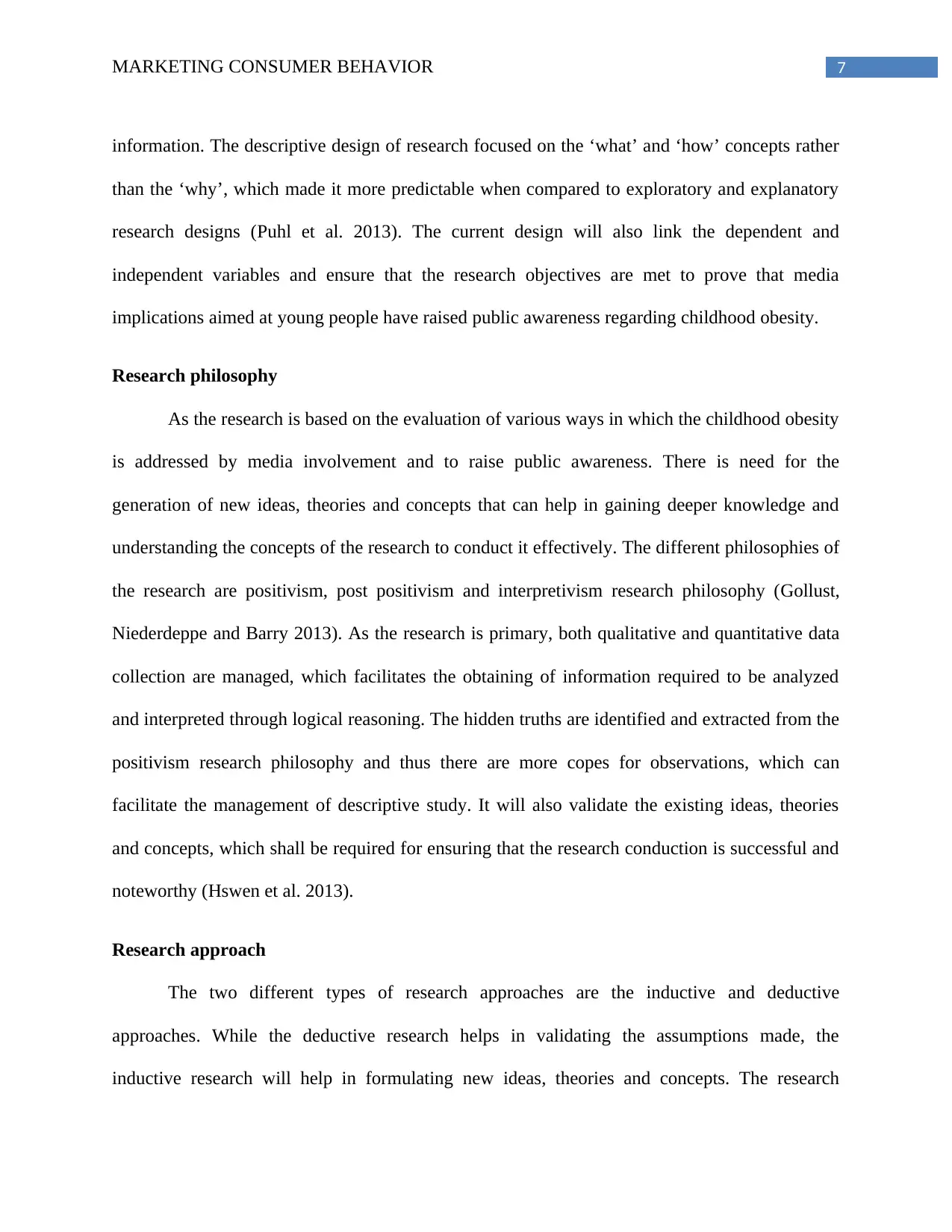
7MARKETING CONSUMER BEHAVIOR
information. The descriptive design of research focused on the ‘what’ and ‘how’ concepts rather
than the ‘why’, which made it more predictable when compared to exploratory and explanatory
research designs (Puhl et al. 2013). The current design will also link the dependent and
independent variables and ensure that the research objectives are met to prove that media
implications aimed at young people have raised public awareness regarding childhood obesity.
Research philosophy
As the research is based on the evaluation of various ways in which the childhood obesity
is addressed by media involvement and to raise public awareness. There is need for the
generation of new ideas, theories and concepts that can help in gaining deeper knowledge and
understanding the concepts of the research to conduct it effectively. The different philosophies of
the research are positivism, post positivism and interpretivism research philosophy (Gollust,
Niederdeppe and Barry 2013). As the research is primary, both qualitative and quantitative data
collection are managed, which facilitates the obtaining of information required to be analyzed
and interpreted through logical reasoning. The hidden truths are identified and extracted from the
positivism research philosophy and thus there are more copes for observations, which can
facilitate the management of descriptive study. It will also validate the existing ideas, theories
and concepts, which shall be required for ensuring that the research conduction is successful and
noteworthy (Hswen et al. 2013).
Research approach
The two different types of research approaches are the inductive and deductive
approaches. While the deductive research helps in validating the assumptions made, the
inductive research will help in formulating new ideas, theories and concepts. The research
information. The descriptive design of research focused on the ‘what’ and ‘how’ concepts rather
than the ‘why’, which made it more predictable when compared to exploratory and explanatory
research designs (Puhl et al. 2013). The current design will also link the dependent and
independent variables and ensure that the research objectives are met to prove that media
implications aimed at young people have raised public awareness regarding childhood obesity.
Research philosophy
As the research is based on the evaluation of various ways in which the childhood obesity
is addressed by media involvement and to raise public awareness. There is need for the
generation of new ideas, theories and concepts that can help in gaining deeper knowledge and
understanding the concepts of the research to conduct it effectively. The different philosophies of
the research are positivism, post positivism and interpretivism research philosophy (Gollust,
Niederdeppe and Barry 2013). As the research is primary, both qualitative and quantitative data
collection are managed, which facilitates the obtaining of information required to be analyzed
and interpreted through logical reasoning. The hidden truths are identified and extracted from the
positivism research philosophy and thus there are more copes for observations, which can
facilitate the management of descriptive study. It will also validate the existing ideas, theories
and concepts, which shall be required for ensuring that the research conduction is successful and
noteworthy (Hswen et al. 2013).
Research approach
The two different types of research approaches are the inductive and deductive
approaches. While the deductive research helps in validating the assumptions made, the
inductive research will help in formulating new ideas, theories and concepts. The research
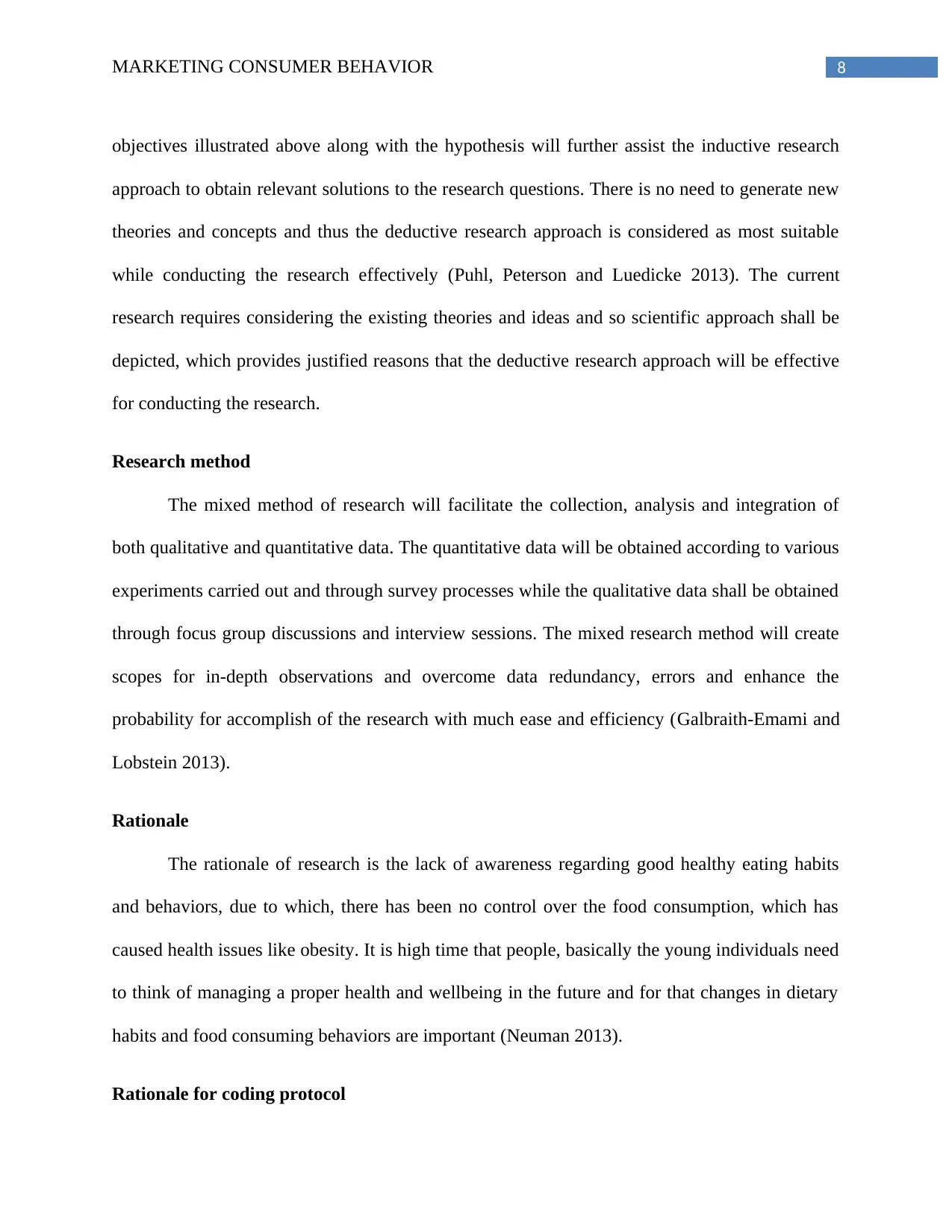
8MARKETING CONSUMER BEHAVIOR
objectives illustrated above along with the hypothesis will further assist the inductive research
approach to obtain relevant solutions to the research questions. There is no need to generate new
theories and concepts and thus the deductive research approach is considered as most suitable
while conducting the research effectively (Puhl, Peterson and Luedicke 2013). The current
research requires considering the existing theories and ideas and so scientific approach shall be
depicted, which provides justified reasons that the deductive research approach will be effective
for conducting the research.
Research method
The mixed method of research will facilitate the collection, analysis and integration of
both qualitative and quantitative data. The quantitative data will be obtained according to various
experiments carried out and through survey processes while the qualitative data shall be obtained
through focus group discussions and interview sessions. The mixed research method will create
scopes for in-depth observations and overcome data redundancy, errors and enhance the
probability for accomplish of the research with much ease and efficiency (Galbraith‐Emami and
Lobstein 2013).
Rationale
The rationale of research is the lack of awareness regarding good healthy eating habits
and behaviors, due to which, there has been no control over the food consumption, which has
caused health issues like obesity. It is high time that people, basically the young individuals need
to think of managing a proper health and wellbeing in the future and for that changes in dietary
habits and food consuming behaviors are important (Neuman 2013).
Rationale for coding protocol
objectives illustrated above along with the hypothesis will further assist the inductive research
approach to obtain relevant solutions to the research questions. There is no need to generate new
theories and concepts and thus the deductive research approach is considered as most suitable
while conducting the research effectively (Puhl, Peterson and Luedicke 2013). The current
research requires considering the existing theories and ideas and so scientific approach shall be
depicted, which provides justified reasons that the deductive research approach will be effective
for conducting the research.
Research method
The mixed method of research will facilitate the collection, analysis and integration of
both qualitative and quantitative data. The quantitative data will be obtained according to various
experiments carried out and through survey processes while the qualitative data shall be obtained
through focus group discussions and interview sessions. The mixed research method will create
scopes for in-depth observations and overcome data redundancy, errors and enhance the
probability for accomplish of the research with much ease and efficiency (Galbraith‐Emami and
Lobstein 2013).
Rationale
The rationale of research is the lack of awareness regarding good healthy eating habits
and behaviors, due to which, there has been no control over the food consumption, which has
caused health issues like obesity. It is high time that people, basically the young individuals need
to think of managing a proper health and wellbeing in the future and for that changes in dietary
habits and food consuming behaviors are important (Neuman 2013).
Rationale for coding protocol
⊘ This is a preview!⊘
Do you want full access?
Subscribe today to unlock all pages.

Trusted by 1+ million students worldwide
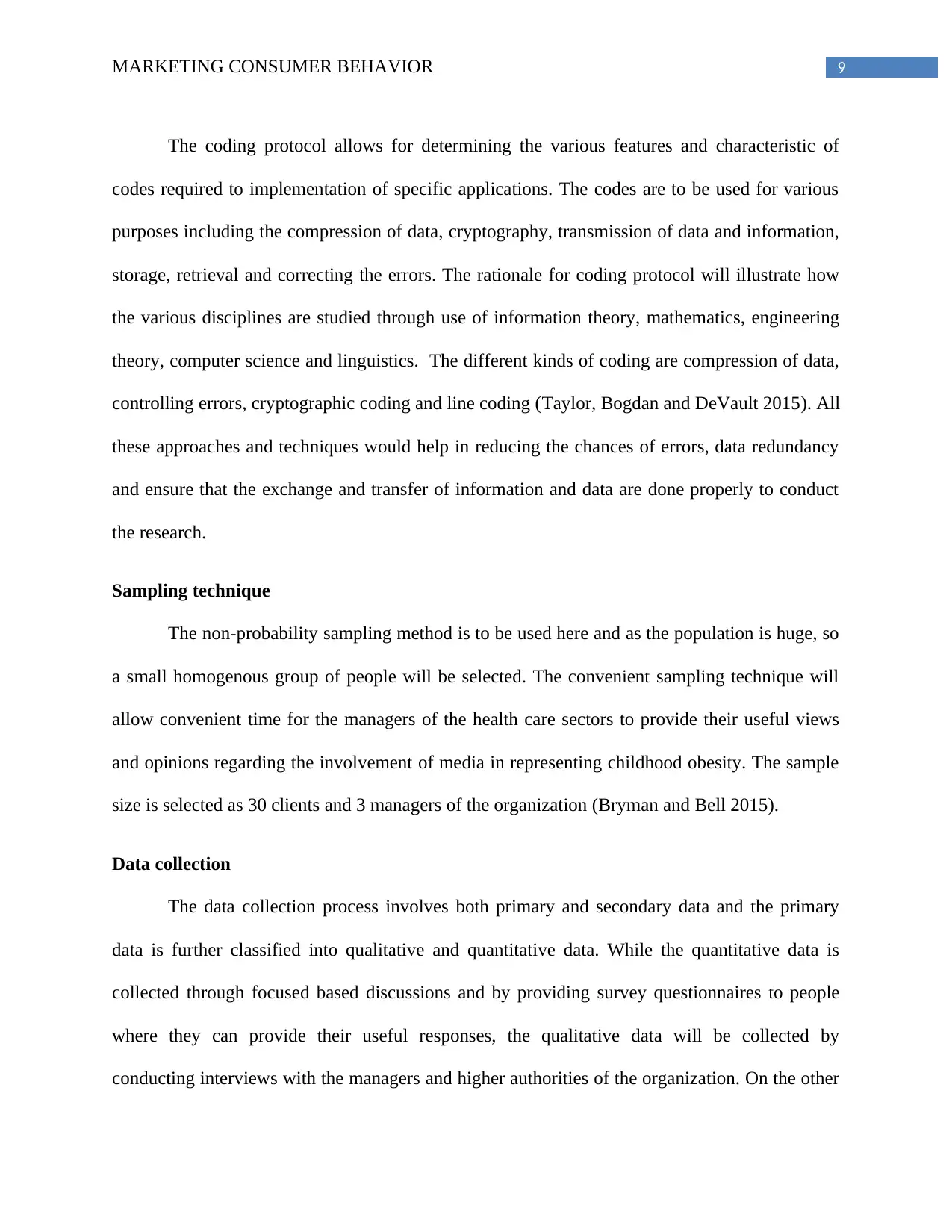
9MARKETING CONSUMER BEHAVIOR
The coding protocol allows for determining the various features and characteristic of
codes required to implementation of specific applications. The codes are to be used for various
purposes including the compression of data, cryptography, transmission of data and information,
storage, retrieval and correcting the errors. The rationale for coding protocol will illustrate how
the various disciplines are studied through use of information theory, mathematics, engineering
theory, computer science and linguistics. The different kinds of coding are compression of data,
controlling errors, cryptographic coding and line coding (Taylor, Bogdan and DeVault 2015). All
these approaches and techniques would help in reducing the chances of errors, data redundancy
and ensure that the exchange and transfer of information and data are done properly to conduct
the research.
Sampling technique
The non-probability sampling method is to be used here and as the population is huge, so
a small homogenous group of people will be selected. The convenient sampling technique will
allow convenient time for the managers of the health care sectors to provide their useful views
and opinions regarding the involvement of media in representing childhood obesity. The sample
size is selected as 30 clients and 3 managers of the organization (Bryman and Bell 2015).
Data collection
The data collection process involves both primary and secondary data and the primary
data is further classified into qualitative and quantitative data. While the quantitative data is
collected through focused based discussions and by providing survey questionnaires to people
where they can provide their useful responses, the qualitative data will be collected by
conducting interviews with the managers and higher authorities of the organization. On the other
The coding protocol allows for determining the various features and characteristic of
codes required to implementation of specific applications. The codes are to be used for various
purposes including the compression of data, cryptography, transmission of data and information,
storage, retrieval and correcting the errors. The rationale for coding protocol will illustrate how
the various disciplines are studied through use of information theory, mathematics, engineering
theory, computer science and linguistics. The different kinds of coding are compression of data,
controlling errors, cryptographic coding and line coding (Taylor, Bogdan and DeVault 2015). All
these approaches and techniques would help in reducing the chances of errors, data redundancy
and ensure that the exchange and transfer of information and data are done properly to conduct
the research.
Sampling technique
The non-probability sampling method is to be used here and as the population is huge, so
a small homogenous group of people will be selected. The convenient sampling technique will
allow convenient time for the managers of the health care sectors to provide their useful views
and opinions regarding the involvement of media in representing childhood obesity. The sample
size is selected as 30 clients and 3 managers of the organization (Bryman and Bell 2015).
Data collection
The data collection process involves both primary and secondary data and the primary
data is further classified into qualitative and quantitative data. While the quantitative data is
collected through focused based discussions and by providing survey questionnaires to people
where they can provide their useful responses, the qualitative data will be collected by
conducting interviews with the managers and higher authorities of the organization. On the other
Paraphrase This Document
Need a fresh take? Get an instant paraphrase of this document with our AI Paraphraser
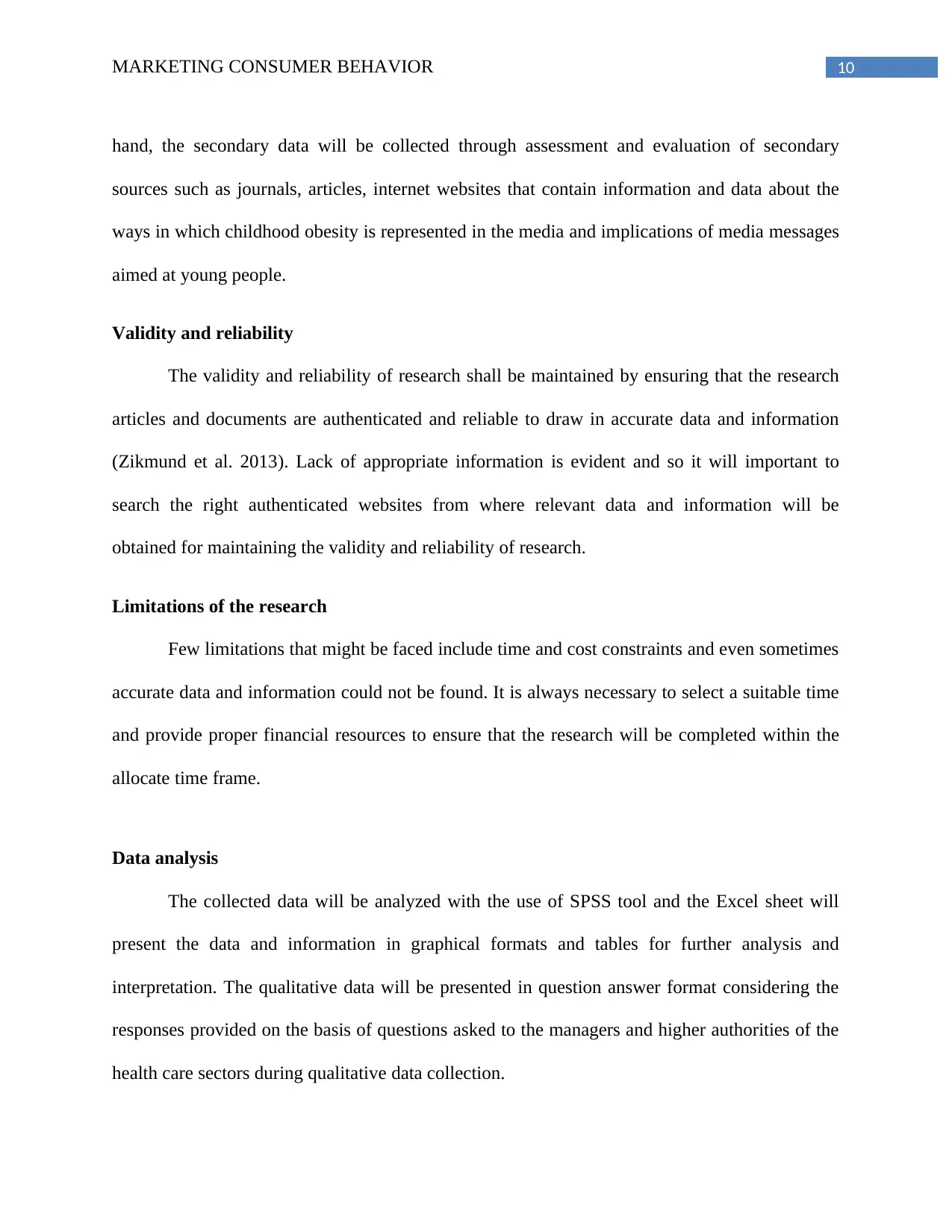
10MARKETING CONSUMER BEHAVIOR
hand, the secondary data will be collected through assessment and evaluation of secondary
sources such as journals, articles, internet websites that contain information and data about the
ways in which childhood obesity is represented in the media and implications of media messages
aimed at young people.
Validity and reliability
The validity and reliability of research shall be maintained by ensuring that the research
articles and documents are authenticated and reliable to draw in accurate data and information
(Zikmund et al. 2013). Lack of appropriate information is evident and so it will important to
search the right authenticated websites from where relevant data and information will be
obtained for maintaining the validity and reliability of research.
Limitations of the research
Few limitations that might be faced include time and cost constraints and even sometimes
accurate data and information could not be found. It is always necessary to select a suitable time
and provide proper financial resources to ensure that the research will be completed within the
allocate time frame.
Data analysis
The collected data will be analyzed with the use of SPSS tool and the Excel sheet will
present the data and information in graphical formats and tables for further analysis and
interpretation. The qualitative data will be presented in question answer format considering the
responses provided on the basis of questions asked to the managers and higher authorities of the
health care sectors during qualitative data collection.
hand, the secondary data will be collected through assessment and evaluation of secondary
sources such as journals, articles, internet websites that contain information and data about the
ways in which childhood obesity is represented in the media and implications of media messages
aimed at young people.
Validity and reliability
The validity and reliability of research shall be maintained by ensuring that the research
articles and documents are authenticated and reliable to draw in accurate data and information
(Zikmund et al. 2013). Lack of appropriate information is evident and so it will important to
search the right authenticated websites from where relevant data and information will be
obtained for maintaining the validity and reliability of research.
Limitations of the research
Few limitations that might be faced include time and cost constraints and even sometimes
accurate data and information could not be found. It is always necessary to select a suitable time
and provide proper financial resources to ensure that the research will be completed within the
allocate time frame.
Data analysis
The collected data will be analyzed with the use of SPSS tool and the Excel sheet will
present the data and information in graphical formats and tables for further analysis and
interpretation. The qualitative data will be presented in question answer format considering the
responses provided on the basis of questions asked to the managers and higher authorities of the
health care sectors during qualitative data collection.
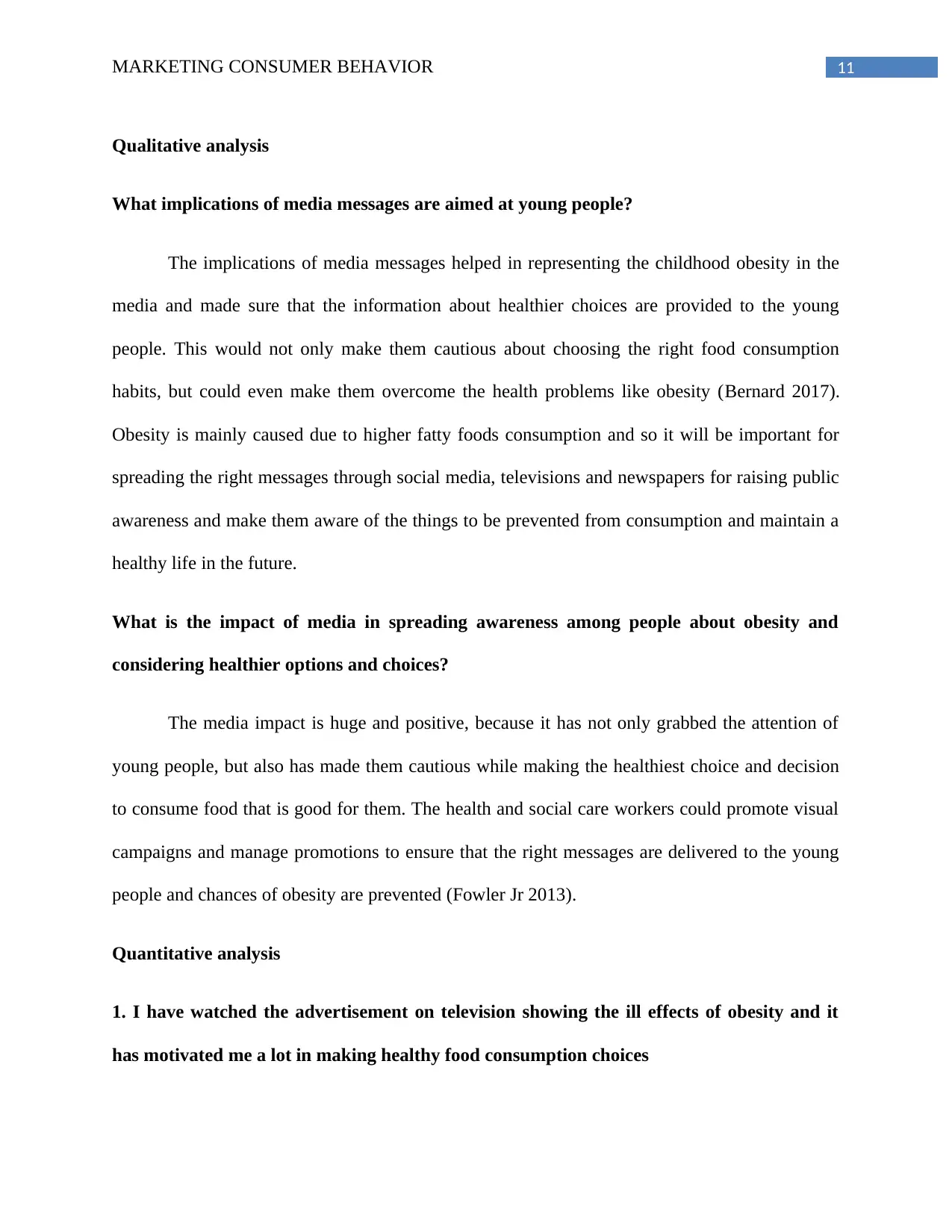
11MARKETING CONSUMER BEHAVIOR
Qualitative analysis
What implications of media messages are aimed at young people?
The implications of media messages helped in representing the childhood obesity in the
media and made sure that the information about healthier choices are provided to the young
people. This would not only make them cautious about choosing the right food consumption
habits, but could even make them overcome the health problems like obesity (Bernard 2017).
Obesity is mainly caused due to higher fatty foods consumption and so it will be important for
spreading the right messages through social media, televisions and newspapers for raising public
awareness and make them aware of the things to be prevented from consumption and maintain a
healthy life in the future.
What is the impact of media in spreading awareness among people about obesity and
considering healthier options and choices?
The media impact is huge and positive, because it has not only grabbed the attention of
young people, but also has made them cautious while making the healthiest choice and decision
to consume food that is good for them. The health and social care workers could promote visual
campaigns and manage promotions to ensure that the right messages are delivered to the young
people and chances of obesity are prevented (Fowler Jr 2013).
Quantitative analysis
1. I have watched the advertisement on television showing the ill effects of obesity and it
has motivated me a lot in making healthy food consumption choices
Qualitative analysis
What implications of media messages are aimed at young people?
The implications of media messages helped in representing the childhood obesity in the
media and made sure that the information about healthier choices are provided to the young
people. This would not only make them cautious about choosing the right food consumption
habits, but could even make them overcome the health problems like obesity (Bernard 2017).
Obesity is mainly caused due to higher fatty foods consumption and so it will be important for
spreading the right messages through social media, televisions and newspapers for raising public
awareness and make them aware of the things to be prevented from consumption and maintain a
healthy life in the future.
What is the impact of media in spreading awareness among people about obesity and
considering healthier options and choices?
The media impact is huge and positive, because it has not only grabbed the attention of
young people, but also has made them cautious while making the healthiest choice and decision
to consume food that is good for them. The health and social care workers could promote visual
campaigns and manage promotions to ensure that the right messages are delivered to the young
people and chances of obesity are prevented (Fowler Jr 2013).
Quantitative analysis
1. I have watched the advertisement on television showing the ill effects of obesity and it
has motivated me a lot in making healthy food consumption choices
⊘ This is a preview!⊘
Do you want full access?
Subscribe today to unlock all pages.

Trusted by 1+ million students worldwide
1 out of 19
Related Documents
Your All-in-One AI-Powered Toolkit for Academic Success.
+13062052269
info@desklib.com
Available 24*7 on WhatsApp / Email
![[object Object]](/_next/static/media/star-bottom.7253800d.svg)
Unlock your academic potential
Copyright © 2020–2025 A2Z Services. All Rights Reserved. Developed and managed by ZUCOL.





